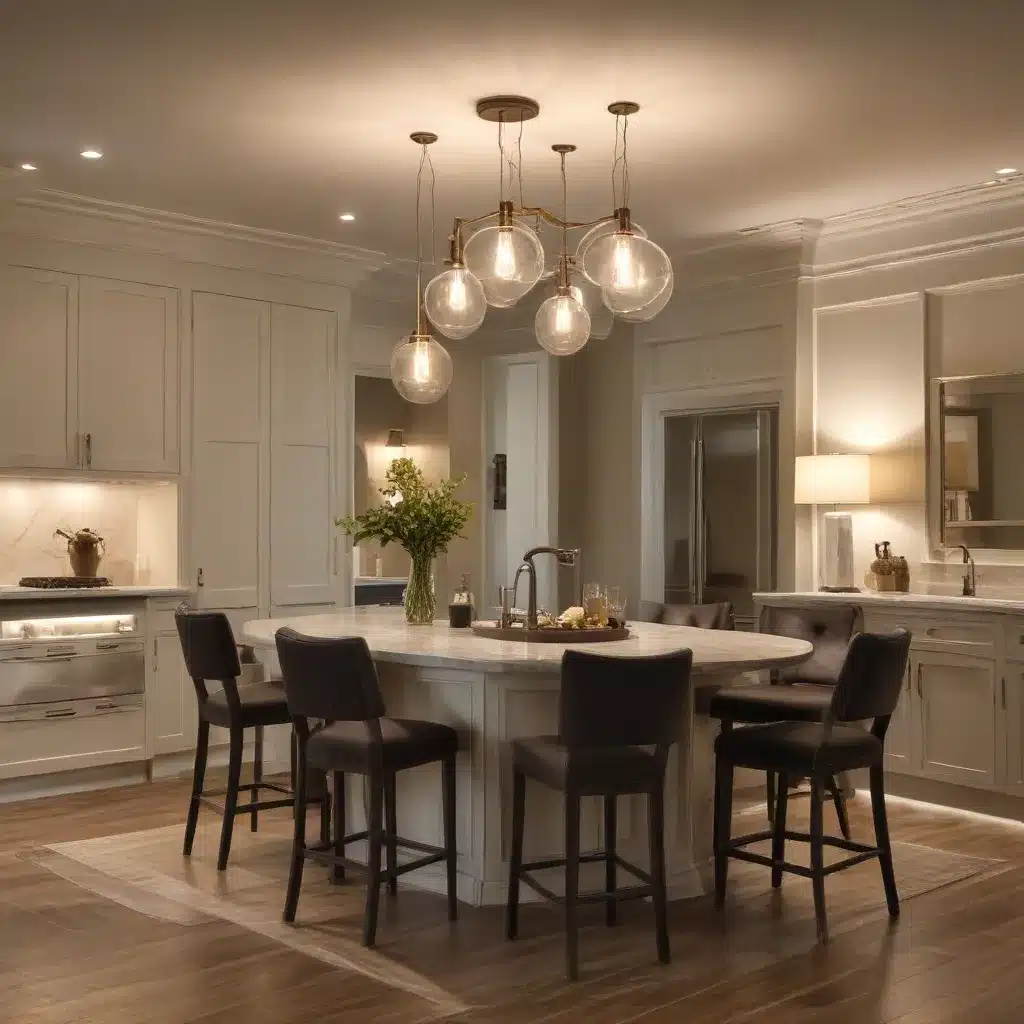
As a seasoned construction professional and interior designer, I know that effective lighting can transform any space, both indoors and out. One of the most powerful techniques in my arsenal is light layering – the strategic combination of different lighting types to create a cohesive, functional, and visually stunning environment. In this comprehensive guide, I’ll share my expert insights on mastering the art of lighting layering to elevate your residential projects.
Understanding the Three Lighting Layers
The foundation of any well-designed lighting scheme lies in balancing three key elements: ambient, task, and accent lighting. Let’s dive deeper into each layer and explore how they work together.
Ambient Lighting
Ambient lighting is the foundational layer that provides overall illumination, creating a comfortable and inviting atmosphere. This can come from a variety of sources, such as recessed downlights, wall sconces, or even strategically placed landscape lighting in outdoor spaces. The goal with ambient lighting is to ensure even, uniform brightness, avoiding any dark spots or uneven illumination.
When planning your ambient lighting, consider the activities and uses of the space. For example, your front porch may require a different ambient lighting setup than your backyard deck, based on how you intend to utilize those areas. Positioning the fixtures thoughtfully is key to achieving the desired effect.
Task Lighting
Task lighting is the second layer, focused on providing concentrated illumination for specific activities. This could include pathway lights to ensure safe navigation, deck lights to highlight stairways, or under-cabinet lighting in the kitchen to aid in meal preparation. The purpose of task lighting is to eliminate shadows, glare, and eye strain by directing light precisely where it’s needed most.
Carefully consider the function of each area when selecting and positioning your task lighting fixtures. For instance, you may want brighter, more intense task lighting over your outdoor kitchen counter compared to the softer illumination in a reading nook.
Accent Lighting
The final layer, accent lighting, is all about adding visual interest and highlighting specific features. This could involve spotlights to showcase architectural elements, uplights to emphasize the texture of a stone wall, or decorative lights to draw attention to a water feature or sculpture. Accent lighting helps create depth, drama, and a sense of intentionality in your outdoor space.
When placing accent lights, focus on showcasing your most compelling design elements without overpowering the scene. Subtlety is key – you want to accentuate, not overwhelm.
Integrating the Lighting Layers
Now that we’ve explored the individual components, let’s discuss strategies for seamlessly integrating these lighting layers to achieve a cohesive and balanced design.
Coordinating Fixtures and Finishes
One of the first steps is to choose lighting fixtures from the same brand or collection. This helps maintain a consistent aesthetic throughout your outdoor space. Look for companies like CAST Lighting that offer a wide range of durable, high-quality options in various styles and finishes.
Balancing Brightness and Avoiding Over-Illumination
Achieving the right balance of brightness is crucial. Install dimmers on your ambient lighting to allow for adjustments based on the time of day or desired mood. Utilize a central control system to manage your lights, enabling you to switch off or dim certain fixtures to create different ambiances.
When it comes to task and accent lighting, ensure they are bright enough to serve their intended purpose without overpowering the space. Focus the lights on the key areas without creating glare or unintended hotspots.
Maintaining a Cohesive Aesthetic
To ensure a harmonious look, be mindful of the color temperature of your lights. Opt for fixtures with similar color temperatures, whether warm (2700K-3000K) for a cozy atmosphere or cooler (4000K-5000K) for a more modern feel. This consistency helps tie the different lighting layers together.
Conceal wiring and fixtures as much as possible to maintain a clean, uncluttered appearance. Utilize landscaping elements, architectural features, or other design details to hide cables and mounting hardware.
Testing and Adjusting
Once your lighting system is installed, take the time to test it at night and make any necessary adjustments. Evaluate the overall balance, brightness levels, and the emphasis on your desired focal points. Be prepared to tweak the placement or intensity of certain fixtures to achieve the perfect lighting scheme.
Elevating Your Outdoor Spaces with High-Quality Fixtures
Investing in durable, well-designed lighting fixtures is essential for the longevity and performance of your lighting layering system. Look for brands like CAST Lighting that use robust materials, such as solid bronze, to withstand the elements and maintain their aesthetic appeal over time.
CAST Lighting offers a wide range of options, from classic lanterns and wall sconces for ambient lighting to precise spotlights and uplights for accent illumination. Their lifetime guarantee is a testament to the quality and craftsmanship of their products, giving you the peace of mind to create your dream outdoor oasis.
Conclusion
Mastering the art of lighting layering is a game-changer for transforming your outdoor spaces. By strategically combining ambient, task, and accent lighting, you can create an inviting, functional, and visually captivating environment.
Remember to plan your layout thoughtfully, choose high-quality fixtures, and fine-tune the system until you achieve the perfect balance. With these expert techniques and the right lighting products, you can elevate your residential projects and bring your design vision to life.
If you’re ready to kick-start your lighting layering project, visit the CAST Lighting website to explore their exceptional range of outdoor lighting solutions. Prepare to be amazed by the transformative power of layered lighting.


